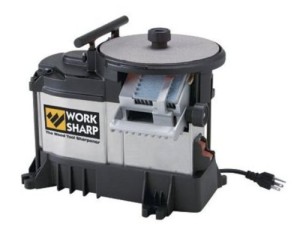
Tool Review: Work Sharp 3000
This Work Sharp 3000 is simple in concept. It’s a sandpaper based system that comes with 2 tempered glass disks. On each side of each disk, you mount an adhesive sandpaper disk. On one disk you put course paper, 120 and 400. On the other you put fine paper, 1000 and some micromesh. There is also a wheel with slots in it and matching slotted paper. With this you can see through the top of the sharpening system for freehand use, especially with lathe gouges. Â
Follow the instructions and clean the disks with acetone prior to slapping on the sandpaper disks. Â They will stick better on a clean surface.
 The tool is very intuitive to use (Translation: I didn’t read the directions terribly thoroughly before diving in with an old chisel.) I started by lapping the blade (flattening the back edge) with the disk mounted in the tool (easy knob) with the 120 grit side up. It’s pretty obvious (and stated in the instructions) that you make sure that you run the tool on the top of the disk to the right, so it is spinning AWAY from the tool. After a quick few passes, I stopped the machine and flipped the disk so the 400 grit was facing upward. Then I ran a few passes on the back of the blade again.
The tool is very intuitive to use (Translation: I didn’t read the directions terribly thoroughly before diving in with an old chisel.) I started by lapping the blade (flattening the back edge) with the disk mounted in the tool (easy knob) with the 120 grit side up. It’s pretty obvious (and stated in the instructions) that you make sure that you run the tool on the top of the disk to the right, so it is spinning AWAY from the tool. After a quick few passes, I stopped the machine and flipped the disk so the 400 grit was facing upward. Then I ran a few passes on the back of the blade again.
The back flattened, I prepared to use the guide and start grinding on the beveled edge. Had I read the instructions first, I would have realized that the slot has an adjustable fence that can be moved to fit the width of the blade. Instead I just maintained pressure against one edge. (I figured it out eventually.) With a quick pulsing action I moved the chisel into the spinning disk, touching the abrasive for about a second at a time. In suprisingly short order I was able to get a clean bevel and remove all the nicks from the edge. The abrasive material mounted on the slide removes any burr that forms on the back.
Once satisfied that bevel was uniform, I flipped over the disk so the 400 grit was facing downward and repeated the process. This visibly removed many of the larger abrasions on the surface of the bevel. At this point the chisel was already getting sharp.
The next step was to change out the glass disk for the one with the finer abrasives. Again I started with the courser face up and lapped the blade, flipped it lapped again with the micromesh, and then began working on the beveled edge with the 1000 grit in quick 1 second touches. By this time, I’d figured out that I could move the fence guide to more closely fit the chisel. The sound of the grind was decidely different than with the courser material. Inspection revealed that it was removing all of deeper scratches and replacing them with finer ones. After flipping the wheel again, and running the blade into the micromesh, the blade was razor sharp (I have a nice bald spot on my forearm to prove it.)
Not satisified with this, I also bought the leather strop accessory. Using this with polishing compound brings the blade up to a near mirror finish.
The verdict:
In the space of about 2 hours, I was able to sharpen 2 chisels and 2″ plane iron up to the afore-stated sharpness. This is quite a time savings. However, I suspect I will not totally abandon my sharpening stones and jewelers rouge compound. I think that using this tool will allow me to get 90% of the way to “scary sharp” and save me several hours for each plane iron or chisel. I think for most uses this is actually more than sufficient. However, for me, I like the mirror polish I am able to obtain with an Arkansas oil stone and jewelers rouge. So, I’ll still end up spending an extra half hour or so to go beyond this point.
So far, I am extremely pleased with this tool, it’s pretty simple and easy to use, and quickly gets good results. Since I have so many rough irons (e-Bay purchases) to deal with, this is going to save me a lot of time getting them to where they are where I want them. I really like the design and usability of this system. There is little danger of overheating the blade and ruining the temper, and the guide system is pretty much fool proof. It’s very easy and fast to change abrasives, and it you have a lot of sharpening to do, I can see how you could do many blades in batch mode.
It doesn’t beat hand sharpening, but comes very close, enough so that finishing up by hand leaves indistinguishable results from doing the whole process by hand. So, if you have a lot of chisels or planes to sharpen, this tool is for you.
 The posts are coming!
The posts are coming!


1 comment
You are putting me on, aren’t you? I scored 1 out of 99 on an aptitute test in college for a machine operator! That’s true! If I were you, I would use a file. I finally figured out how to file my dull buther knives with an old fashined file my grandfather willed to me! He had me pegged!
[Reply]
Leave a Comment